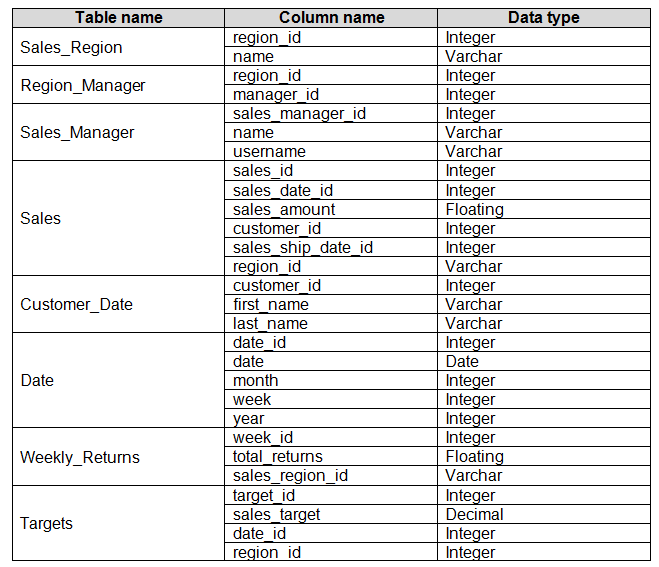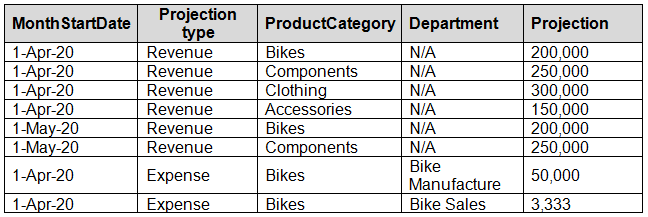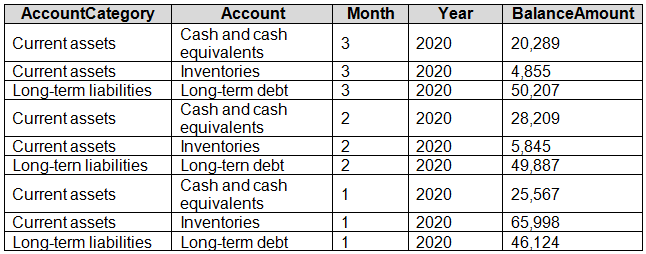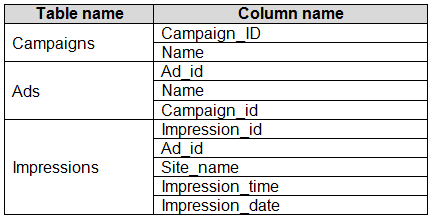Case Study -
This is a case study. Case studies are not timed separately. You can use as much exam time as you would like to complete each case. However, there may be additional case studies and sections on this exam. You must manage your time to ensure that you are able to complete all question included on this exam in the time provided.
To answer the questions included in a case study, you will need to reference information that is provided in the case study. Case studies might contain exhibits and other resources that provide more information about the scenario that is described in the case study. Each question is independent of the other question on this case study.
At the end of this case study, a review screen will appear. This screen allows you to review your answers and to make changes before you move to the next section of the exam. After you begin a new section, you cannot return to this section.
To start the case study -
To display the first question on this case study, click the Next button. Use the buttons in the left pane to explore the content of the case study before you answer the questions. Clicking these buttons displays information such as business requirements, existing environment, and problem statements. If the case study has an All Information tab, note that the information displayed is identical to the information displayed on the subsequent tabs. When you are ready to answer a question, click the Question button to return to the question.
Overview -
Litware, Inc. is an online retailer that uses Microsoft Power BI dashboards and reports.
The company plans to leverage data from Microsoft SQL Server databases, Microsoft Excel files, text files, and several other data sources.
Litware uses Azure Active Directory (Azure AD) to authenticate users.
Existing Environment -
Sales Data -
Litware has online sales data that has the SQL schema shown in the following table.

In the Date table, the date_id column has a format of yyyymmdd and the month column has a format of yyyymm.
The week column in the Date table and the week_id column in the Weekly_Returns table have a format of yyyyww.
The sales_id column in the Sales table represents a unique transaction.
The region_id column can be managed by only one sales manager.
Data Concerns -
You are concerned with the quality and completeness of the sales data. You plan to verify the sales data for negative sales amounts.
Reporting Requirements -
Litware identifies the following technical requirements:
Executives require a visual that shows sales by region.
Regional managers require a visual to analyze weekly sales and returns.
Sales managers must be able to see the sales data of their respective region only.
The sales managers require a visual to analyze sales performance versus sales targets.
The sale department requires reports that contain the number of sales transactions.
Users must be able to see the month in reports as shown in the following example: Feb 2020.
The customer service department requires a visual that can be filtered by both sales month and ship month independently.
You need to create a calculated column to display the month based on the reporting requirements.
Which DAX expression should you use?
- A. FORMAT('Date'[date], "MMM YYYY")
- B. FORMAT('Date' [date], "M YY")
- C. FORMAT('Date'[date_id], "MMM") & "" & FORMAT('Date'[year], "#")
- D. FORMAT('Date' [date_id], "MMM YYYY")
Answer : D
Explanation:
Scenario: In the Date table, the date_id column has a format of yyyymmdd. Users must be able to see the month in reports as shown in the following example:
Feb 2020.
Case Study -
This is a case study. Case studies are not timed separately. You can use as much exam time as you would like to complete each case. However, there may be additional case studies and sections on this exam. You must manage your time to ensure that you are able to complete all question included on this exam in the time provided.
To answer the questions included in a case study, you will need to reference information that is provided in the case study. Case studies might contain exhibits and other resources that provide more information about the scenario that is described in the case study. Each question is independent of the other question on this case study.
At the end of this case study, a review screen will appear. This screen allows you to review your answers and to make changes before you move to the next section of the exam. After you begin a new section, you cannot return to this section.
To start the case study -
To display the first question on this case study, click the Next button. Use the buttons in the left pane to explore the content of the case study before you answer the questions. Clicking these buttons displays information such as business requirements, existing environment, and problem statements. If the case study has an All Information tab, note that the information displayed is identical to the information displayed on the subsequent tabs. When you are ready to answer a question, click the Question button to return to the question.
Overview -
Litware, Inc. is an online retailer that uses Microsoft Power BI dashboards and reports.
The company plans to leverage data from Microsoft SQL Server databases, Microsoft Excel files, text files, and several other data sources.
Litware uses Azure Active Directory (Azure AD) to authenticate users.
Existing Environment -
Sales Data -
Litware has online sales data that has the SQL schema shown in the following table.

In the Date table, the date_id column has a format of yyyymmdd and the month column has a format of yyyymm.
The week column in the Date table and the week_id column in the Weekly_Returns table have a format of yyyyww.
The sales_id column in the Sales table represents a unique transaction.
The region_id column can be managed by only one sales manager.
Data Concerns -
You are concerned with the quality and completeness of the sales data. You plan to verify the sales data for negative sales amounts.
Reporting Requirements -
Litware identifies the following technical requirements:
Executives require a visual that shows sales by region.
Regional managers require a visual to analyze weekly sales and returns.
Sales managers must be able to see the sales data of their respective region only.
The sales managers require a visual to analyze sales performance versus sales targets.
The sale department requires reports that contain the number of sales transactions.
Users must be able to see the month in reports as shown in the following example: Feb 2020.
The customer service department requires a visual that can be filtered by both sales month and ship month independently.
You need to review the data for which there are concerns before creating the data model.
What should you do in Power Query Editor?
- A. Transform the sales_amount column to replace negative values with 0.
- B. Select Column distribution.
- C. Select the sales_amount column and apply a number filter.
- D. Select Column profile, and then select the sales_amount column.
Answer : A
Explanation:
Scenario: Data Concerns -
You are concerned with the quality and completeness of the sales data. You plan to verify the sales data for negative sales amounts.
How to convert negative numbers into positive numb, editor and right click, select transform, and choose absolute value. That would give the positive number outcome you're looking for.
Reference:
https://www.xspdf.com/resolution/50510644.html
Prepare the Data -
Case Study -
This is a case study. Case studies are not timed separately. You can use as much exam time as you would like to complete each case. However, there may be additional case studies and sections on this exam. You must manage your time to ensure that you are able to complete all questions included on this exam in the time provided.
To answer the questions included in a case study, you will need to reference information that is provided in the case study. Case studies might contain exhibits and other resources that provide more information about the scenario that is described in the case study. Each question is independent of the other question on this case study.
At the end of this case study, a review screen will appear. This screen allows you to review your answers and to make changes before you move to the next section of the exam. After you begin a new section, you cannot return to this section.
To start the case study -
To display the first question on this case study, click the Next button. Use the buttons in the left pane to explore the content of the case study before you answer the questions. Clicking these buttons displays information such as business requirements, existing environment, and problem statements. If the case study has an All Information tab, note that the information displayed is identical to the information displayed on the subsequent tabs. When you are ready to answer a question, click the Question button to return to the question.
Overview -
Contoso, Ltd. is a manufacturing company that produces outdoor equipment. Contoso has quarterly board meetings for which financial analysts manually prepare
Microsoft Excel reports, including profit and loss statements for each of the company's four business units, a company balance sheet, and net income projections for the next quarter.
Existing Environment -
Data and Sources -
Data for the reports comes from three sources. Detailed revenue, cost, and expense data comes from an Azure SQL database. Summary balance sheet data comes from Microsoft Dynamics 365 Business Central. The balance sheet data is not related to the profit and loss results, other than they both relate dates.
Monthly revenue and expense projections for the next quarter come from a Microsoft SharePoint Online list. Quarterly projections relate to the profit and loss results by using the following shared dimensions: date, business unit, department, and product category.
Net Income Projection Data -
Net income projection data is stored in a SharePoint Online list named Projections in the format shown in the following table.

Revenue projections are set at the monthly level and summed to show projections for the quarter.
Balance Sheet Data -
The balance sheet data is imported with final balances for each account per month in the format shown in the following table.

There is always a row for each account for each month in the balance sheet data.
Dynamics 365 Business Central Data
Business Central contains a product catalog that shows how products roll up to product categories, which roll up to business units.
Revenue data is provided at the date and product level. Expense data is provided at the date and department level.
Business Issues -
Historically, it has taken two analysts a week to prepare the reports for the quarterly board meetings. Also, there is usually at least one issue each quarter where a value in a report is wrong because of a bad cell reference in an Excel formula. On occasion, there are conflicting results in the reports because the products and departments that roll up to each business unit are not defined consistently.
Requirements -
Planned Changes -
Contoso plans to automate and standardize the quarterly reporting process by using Microsoft Power BI. The company wants to how long it takes to populate reports to less than two days. The company wants to create common logic for business units, products, and departments to be used across all reports, including, but not limited, to the quarterly reporting for the board.
Technical Requirements -
Contoso wants the reports and datasets refreshed with minimal manual effort.
The company wants to provide a single package of reports to the board that contains custom navigation and links to supplementary information.
Maintenance, including manually updating data and access, must be minimized as much as possible.
Security Requirements -
The reports must be made available to the board from powerbi.com. A mail-enabled security group will be used to share information with the board.
The analysts responsible for each business unit must see all the data the board sees, except the profit and loss data, which must be restricted to only their business unit's data. The analysts must be able to build new reports from the dataset that contains the profit and loss data, but any reports that the analysts build must not be included in the quarterly reports for the board. The analysts must not be able to share the quarterly reports with anyone.
Report Requirements -
You plan to relate the balance sheet to a standard date table in Power BI in a many-to-one relationship based on the last day of the month. At least one of the balance sheet reports in the quarterly reporting package must show the ending balances for the quarter, as well as for the previous quarter.
Projections must contain a column named RevenueProjection that contains the revenue projection amounts. A relationship must be created from Projections to a table named Date that contains the columns shown in the following table.

The definitions and attributes of products, departments, and business units must be consistent across all reports.
The board must be able to get the following information from the quarterly reports:
Revenue trends over time
Ending balances for each account
A comparison of expenses versus projections by quarter
Changes in long-term liabilities from the previous quarter
A comparison of quarterly revenue versus the same quarter during the prior year
What is the minimum number of Power BI datasets needed to support the reports?
- A. two imported datasets
- B. a single DirectQuery dataset
- C. two DirectQuery datasets
- D. a single imported dataset
Answer : A
Explanation:
Scenario: Data and Sources -
Data for the reports comes from three sources. Detailed revenue, cost, and expense data comes from an Azure SQL database. Summary balance sheet data comes from Microsoft Dynamics 365 Business Central. The balance sheet data is not related to the profit and loss results, other than they both relate dates.
Monthly revenue and expense projections for the next quarter come from a Microsoft SharePoint Online list. Quarterly projections relate to the profit and loss results by using the following shared dimensions: date, business unit, department, and product category.
Reference:
https://docs.microsoft.com/en-us/power-bi/connect-data/service-datasets-understand
Prepare the Data -
You have a custom connector that returns ID, From, To, Subject, Body, and Has Attachments for every email sent during the past year. More than 10 million records are returned.
You build a report analyzing the internal networks of employees based on whom they send emails to.
You need to prevent report recipients from reading the analyzed emails. The solution must minimize the model size.
What should you do?
- A. Implement row-level security (RLS) so that the report recipients can only see results based on the emails they sent.
- B. Remove the Subject and Body columns during the import.
- C. From Model view, set the Subject and Body columns to Hidden.
Answer : B
Explanation:
Incorrect Answers:
A, C: Does not reduce the size of the model.
You have the tables shown in the following table.

The Impressions table contains approximately 30 million records per month.
You need to create an ad analytics system to meet the following requirements:
✑ Present ad impression counts for the day, campaign, and Site_name. The analytics for the last year are required.
✑ Minimize the data model size.
Which two actions should you perform? Each correct answer presents part of the solution.
NOTE: Each correct selection is worth one point.
- A. Group the impressions by Ad_id, Site_name, and Impression_date. Aggregate by using the CountRows function.
- B. Create one-to-many relationships between the tables.
- C. Create a calculated measure that aggregates by using the COUNTROWS function.
- D. Create a calculated table that contains Ad_id, Site_name, and Impression_date.
Answer : AB

